Why Dental Care in People and Pups is Similar…And Very Different.
As both National Pet Dental Health Month and National Children’s Dental Health Month, February is an important month for those pearly whites.
In this article, we’re going to take a closer look at how human dental health and pet dental health are both very similar and very different, both in how disease affects teeth, as well as how dental disease is approached.
How is Dental Disease Similar Between People and Dogs?
The earliest battle in dental health is against plaque build-up and this is similar across the board between people and pets alike.
Plaque, that sticky film that forms on the teeth over the course of the day, is composed of microscopic bits of food, saliva, and bacteria. Over time this bacterial plaque leads to inflammation along the gums, which is called gingivitis.
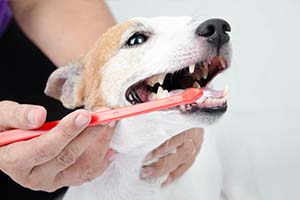 This inflammation caused by bacterial plaque can also extend below the gumline and lead to periodontitis, where the bone keeping teeth in place starts to erode, eventually leading to tooth loss.
This inflammation caused by bacterial plaque can also extend below the gumline and lead to periodontitis, where the bone keeping teeth in place starts to erode, eventually leading to tooth loss.
On the surface of the teeth, plaque will eventually harden into tartar or calculus if not addressed. At this stage, the yellow/brown tartar can no longer be brushed off, but requires more advanced dental care to remove.
If left untreated, bacterial gingivitis and periodontitis don’t just affect health in the mouth. Once they cause so much inflammation in the mouth, the bacteria can enter the bloodstream and cause problems in other organs, leading to systemic problems throughout the body.
In both pets and people, multiple studies over the years have connected chronic dental disease to cardiovascular (heart) disease, systemic blood infections, liver disease, kidney disease, and insulin resistance contributing to diabetes, to name a few.
How is Dental Disease Different Between Dogs and People?
The Crummy Cavity
The biggest difference between human dental disease and dental disease in pets is the notorious cavity.
In people, dental caries or tooth decay occurs frequently. When the bacteria in plaque are exposed to certain foods, they produce acids that erode away the protective enamel of a tooth, causing a literal hole, or cavity in the tooth.
But interestingly in pets, we rarely ever see true cavities. According to the National Institutes of Health, over 90% of humans between about 25 and 65 years of age get cavities. But in contrast, only about 5% of dogs do. Part of the suspected reason for this big difference is in how our teeth are shaped very differently from our pets.
With the exception of our incisors and canine teeth, human teeth are very flat. They also butt up very close next to each other along their height from the gumline to the tip of the crown, leaving very little space between them (which is why flossing is so important!).
These flat surfaces and close contact between teeth allow for plaque to sit and fester on these surfaces and for acids to progressively bore away at enamel.
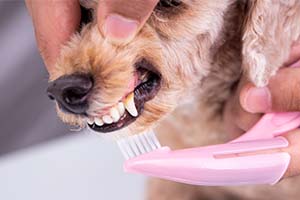 In dogs, their teeth are largely very sharp and slanted, also described as “conical” in shape. The only exceptions include the last two molars on the top and bottom, with the back half of the third to last molar on the bottom also being at higher risk. These teeth much more resemble a majority of human teeth, being more flat and in closer contact with each other.
In dogs, their teeth are largely very sharp and slanted, also described as “conical” in shape. The only exceptions include the last two molars on the top and bottom, with the back half of the third to last molar on the bottom also being at higher risk. These teeth much more resemble a majority of human teeth, being more flat and in closer contact with each other.
The conical shape of a majority of a dog’s teeth, combined with a greater interdental space between them compared to a person’s, is a big part of what contributes to such a low likelihood of dental caries in pets. Dogs also have a slightly higher pH in their mouths, meaning it is less acidic.
The high pH offsets the acid produced by bacteria, preventing the type of acidic erosion so often seen in people.
Cousin of the Cavity
There is a type of lesion also seen in dogs but more commonly recognized in cats, called a resorptive lesion, which closely resembles a cavity when seen on the surface. Resorptive lesions also appear as small holes in the tooth at first. But unlike a cavity, the process is not caused by bacteria.
While the specific cause is still not known and has not been linked to anything in particular, it is thought to be an immune-related process.
Over time, this irreversible resorption process will continue to develop either from the inside or outside of the tooth until the entire tooth painfully dissolves itself and the gums cover it over.
While people can also get resorptive-type lesions, the causes appear to be largely different from those seen in pets.
A Bad Break
The second biggest difference between dogs and people is that worn and fractured teeth are so much more common in dogs.
Part of this is simply because a majority of a dog’s toys are chewable items. And if you don’t provide a chewable item, a dog may always find something else to chew on, like a stick. While this can be a normal behavior, we have to control what our dogs are chomping on.
Generally, harder objects like bones are too hard for dog’s teeth and more often lead to fractures, especially of the very large pointy premolars on the top, called the carnassials.
In people, our roots are very short and straight compared to a dog’s which are long and angled. This keeps their teeth in their mouth quite a bit more successfully, which is necessary for a predator trying to catch moving prey as dogs in the wild or their close cousins wolves and coyotes, must do.
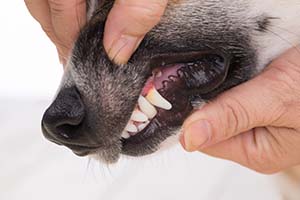 But a tooth is going to give somewhere under enough strain, and so usually this is going to be some part of the visible crown that cracks, especially where it’s thinner near the tip.
But a tooth is going to give somewhere under enough strain, and so usually this is going to be some part of the visible crown that cracks, especially where it’s thinner near the tip.
If a tooth is fractured far enough down from the tip of the crown, this exposes the pulp cavity to all of that bacteria in the mouth. This can ultimately lead to infection and compromise of the tooth.
Worn Out
Tooth wear on a dog’s teeth also occurs secondary to what a dog is chewing on. Some objects can be very abrasive. Surprising to most, your common tennis ball can be one of the worst offenders. All of those microscopic fibers, coupled with dirt accumulation over time, act like sandpaper on a dog’s teeth. Abrasive rope toys can have a similar effect too.
Soft but durable rubber/plastic toys are the best type of toy to provide to your dog. The material has enough give to avoid fractures, is soft enough to not be abrasive, but durable enough to not get chewed up into small pieces and lead to a potential digestive obstruction risk.
How is Dental Care Similar Between People and Pets?
Brushing: Always the Basics
Because plaque and tartar buildup occur in both people and pets, brushing is a hallmark of regular care in both cases.
In people, brushing at least twice a day is recommended to prevent that plaque build-up that happens in earnest within several hours after the last brushing. In dogs, the gold standard for brushing isn’t any different. If you can get your dog into such a routine, you’ll be doing your best friend the best favor to prevent progression of dental disease.
But since it can be a struggle sometimes, the minimum recommendation for dogs is brushing at least 3 times a week. Any less frequent than that and you’re accomplishing very little to slow down the formation of tartar on the teeth.
Dog Dental Cleaning Basics
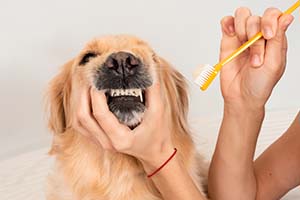 And while brushing is the best preventative to keep tartar at bay, once that tartar develops, brushing cannot be used to remove it. This is why dental cleanings with a dentist twice a year are recommended for people. Many of the same tools human dentists use to clean teeth on the surface are also used by veterinarians during dental cleaning procedures.
And while brushing is the best preventative to keep tartar at bay, once that tartar develops, brushing cannot be used to remove it. This is why dental cleanings with a dentist twice a year are recommended for people. Many of the same tools human dentists use to clean teeth on the surface are also used by veterinarians during dental cleaning procedures.
During dental procedures for both pets and people, you have many of the same components. There’s dental x-rays to look at tooth roots and the health of the surrounding bone, probing the mouth to look for deep pockets caused by periodontal disease, scaling that tartar off the ultrasonic scaler, and polishing the teeth to make them nice and pearly white.
How is Dental Care Different Between People and Pets?
Fluoride and Flavors
Many folks out there reading will immediately recognize that the biggest difference in pet dental care is that cleaning procedures are performed under anesthesia. We’ll get to that in just a second, but first, there is a major difference just with brushing and home care.
Fluoride is a mainstay of reducing dental disease in people. Fluoride toothpaste is a standard and drinking water has been treated with fluoride going as far back as the 1940’s.
But pets are very sensitive to fluoride, so their toothpaste, which also tends to have a carnal assortment of flavors like liver and beef instead of bubblegum, are fluoride-free.
In pets, we also have the option of bolstering home care using dental treats and oral water additives. For a full list of products found to most significantly reduce plaque and tartar build-up, see the list of Veterinary Oral Health Council approved products.
Dog Dental Cleanings: Why is Anesthesia Standard?
Even with some degree of regular home care, a full dental cleaning will eventually be recommended by your veterinarian. And yes, unlike for most cases in people, dental cleanings for pets are done under full anesthesia.
While on the surface this may immediately seem extreme, it only takes a review of what occurs during a dental cleaning–whether you’re a dog or a person–to understand why anesthetic dental procedures have been the standard in veterinary care for a long time.
When you go to the dentist yourself, the first thing done typically is a set of dental x-rays. They stick the bite wing in your mouth, you sit down in a chair, and while you stay very still, they rotate the x-ray machine around your head a couple of times to get the necessary views.
After that, you head into the dental chair for the hygienist or an assistant and the dentist to have a look in your mouth. Your mouth is propped open or you have to keep it open while they check each tooth in a couple of places to see what the depth of the space is between the gums and the tooth, which is called the gingival sulcus. A deep gingival sulcus, usually greater than 2-3 millimeters, indicates that concerning periodontal disease is present.
The dentist also checks for the presence of cavities or other concerns. After that, they have a chat with you about the findings and what you’re in store for, including estimated costs and what portion your insurance will be able to cover.
If we try to reproduce these steps with a dog, we immediately run into problems. Sticking a bite wing into a pup’s mouth, or in the case of veterinary medicine, the x-ray plate itself, and asking him to stay perfectly still and not chew it while a machine is placed an inch from his head is a lot to ask for.
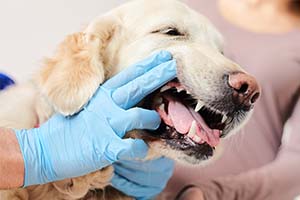 The probing part is also problematic. While a vet can get a good look at a dog’s mouth on the surface, poking the gums with a pointy metal instrument is another matter. As anyone who’s been to the dentist knows, even that part isn’t the most comfortable.
The probing part is also problematic. While a vet can get a good look at a dog’s mouth on the surface, poking the gums with a pointy metal instrument is another matter. As anyone who’s been to the dentist knows, even that part isn’t the most comfortable.
Even under sedation, a dog can react to poking and prodding, and especially anything painful in the mouth.
The other dilemma then faced is if you need anesthesia to safely get a full dental evaluation, you need to then be fully prepared to take the necessary measures to address any dental disease present, including removing diseased teeth.
If we don’t get a full and complete dental evaluation done, the same as a human dentist requires, then a significant amount of disease may be missed and not addressed. What a veterinarian can see from a basic exam of the mouth and teeth during an annual physical is still missing about 50% of what’s there. And periodontal disease in dogs can sometimes be present under the gumline without severe disease visible on the surface.
How Dog Dental Cleanings Can Differ
In both pets and people, the full dental evaluation is done first. However, while any procedures needed may then happen at a later date, we don’t want to wake a pet up from anesthesia after x-rays and mouth charting are done, only to put them under again later. It is far more efficient and easier on the pet to get this done all at once.
This is why, after x-rays and charting are completed, the vet will then typically call a pup parent while the technician or nurse continues to scale and clean the teeth, to discuss further measures that need to be taken, like possible tooth extractions, so that those can then be done immediately after.
And this gets us to another reason why anesthesia is important. Try to imagine all of the things that take place when you have crowns or fillings put in. Often, one or more local anesthetics are used by injecting a needle into your gums. It’s not pleasant.
After that, there’s lots of high speed drilling, water spraying, suction, propping open your mouth, and other uncomfortable things. This is why many people don’t like going to the dentist. In fact, I have heard more than once from a friend that they wish getting “knocked out” for dental work was a more common option for them.
Even under sedation, a dog would not be able to withstand the discomfort of a local nerve block, and the whine of a high speed drill alone would rouse a pup out of it.
Other Differences in Dental Care
Other differences in dental care can include the types of procedures common in pets versus people.
In people, cavity fillings and crowns are very common. But in pets, since dental caries are comparatively rare, fillings and crowns are also uncommonly needed.
With bone loss and periodontal disease in dogs being the most common problems seen, veterinarians are trained to extract or remove teeth that have lost too much bone or have root exposure. Are procedures available to save such teeth? There are, but these techniques, like bone grafts to try to re-establish lost bone, are considered very advanced and not always successful.
Similar to human dentistry where more advanced procedures may be done by a periodontal specialist or oral surgeon instead of your regular dentist, advanced procedures in pets are performed by a veterinary dental specialist.
Doing Your Dental Part at Home
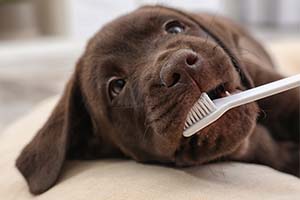 While in people, full dental cleanings are still needed twice a year even when you brush your teeth often, dental cleanings in pets are typically recommended annually, or as often as the degree of dental disease calls for, keeping in mind a pet’s risk for anesthesia.
While in people, full dental cleanings are still needed twice a year even when you brush your teeth often, dental cleanings in pets are typically recommended annually, or as often as the degree of dental disease calls for, keeping in mind a pet’s risk for anesthesia.
Veterinarians do their best to minimize the risk for anesthesia by making sure a recent physical exam is up to date and ensuring a full lab work panel has been done to look at organ function often within 30 days or less of a planned procedure.
But is anesthesia scary for a lot of folks? Sure it is, because while a majority of pets do well for anesthetic cleanings, there are certainly always potential risks involved.
But the good news is that in pets, the number and frequency of anesthetic dental cleanings can often be reduced significantly by regular dental care at home. Try to brush your pet’s teeth as often as possible. If you need help, check out our previous article on How to Brush a Dog’s Teeth in 5 Steps.
As the article says, start slow, gradually work up to more frequency, be patient, and make it a positive experience. You can also combine brushing with dental treats and oral water additives to keep those pearly whites as healthy as possible.
Keeping up with dental care in pets isn’t always easy but putting in the effort at home can certainly pay off. Your dog’s teeth, as well as her body as a whole, will certainly thank you.
Although as mentioned, the full extent of dental disease cannot be seen on a veterinary physical exam alone, a general idea can usually be determined as well as any more serious concerns like bad gingivitis, severe tartar, or broken teeth.
So, if you’re not certain about what your pup’s teeth might look like, make sure to make it a discussion topic at your dog’s next annual or biannual exam, and chat about what steps may be needed with your veterinarian.




 If you’ve ever been to a county animal shelter, chances are it looked pretty full. Depending on the state and the county, a shelter might be very well equipped and staffed to handle a large volume of stray animals, or it might not.
If you’ve ever been to a county animal shelter, chances are it looked pretty full. Depending on the state and the county, a shelter might be very well equipped and staffed to handle a large volume of stray animals, or it might not. It may sound overly simplistic to say that if reproductive organs are removed through spaying or neutering, that any risk of cancer associated with those organs is thus removed 100%, but it’s true. A dog can’t get testicular cancer if he no longer has the family jewels.
It may sound overly simplistic to say that if reproductive organs are removed through spaying or neutering, that any risk of cancer associated with those organs is thus removed 100%, but it’s true. A dog can’t get testicular cancer if he no longer has the family jewels. Some folks may have heard of a pyometra while others may have not. Essentially, it is an infection of the uterus, which fills up with pus, and can only happen to a dog during the period shortly after she finishes a heat cycle. When a dog is in heat, white blood cells are blocked from entering the uterus so that sperm can have safe passage. After heat is over, progesterone kicks in and the uterine wall becomes thickened to prepare for pregnancy.
Some folks may have heard of a pyometra while others may have not. Essentially, it is an infection of the uterus, which fills up with pus, and can only happen to a dog during the period shortly after she finishes a heat cycle. When a dog is in heat, white blood cells are blocked from entering the uterus so that sperm can have safe passage. After heat is over, progesterone kicks in and the uterine wall becomes thickened to prepare for pregnancy. When I think about canine behavior when it comes to sex hormones, I can’t help but think about Cousin Eddie from National Lampoon’s Christmas Vacation. He laughingly tells Clark Griswold that his dog, affectionately named “Snots” (”you ain’t never seen a set on a dog like this one’s got, Clark”), that “if the mood catches him right, he’ll grab your leg and just go to town.”
When I think about canine behavior when it comes to sex hormones, I can’t help but think about Cousin Eddie from National Lampoon’s Christmas Vacation. He laughingly tells Clark Griswold that his dog, affectionately named “Snots” (”you ain’t never seen a set on a dog like this one’s got, Clark”), that “if the mood catches him right, he’ll grab your leg and just go to town.” In practice, I typically encounter four reasons why a pet owner is hesitant to spay or neuter their pet and I think it’s important to address them, because they may be the same reservations you have.
In practice, I typically encounter four reasons why a pet owner is hesitant to spay or neuter their pet and I think it’s important to address them, because they may be the same reservations you have. The term anesthesia is very scary for pet owners. Some of you out there may even have had a pet pass away while having an anesthetic procedure done, which is truly heartbreaking for all involved, including the doctor and hospital staff.
The term anesthesia is very scary for pet owners. Some of you out there may even have had a pet pass away while having an anesthetic procedure done, which is truly heartbreaking for all involved, including the doctor and hospital staff. A third reason I hear from pet owners why they don’t want to spay or neuter their dog or cat is because they would like to use them for breeding. If this is a pet owner’s goal, I typically make sure they understand the risks posed by not spaying or neutering, and that they have some kind of a plan in place. For some folks, breeding their dog (and yes, sometimes their cat) may seem like a good idea with a healthy financial incentive, but it can become more trouble than expected if you don’t know what you’re doing.
A third reason I hear from pet owners why they don’t want to spay or neuter their dog or cat is because they would like to use them for breeding. If this is a pet owner’s goal, I typically make sure they understand the risks posed by not spaying or neutering, and that they have some kind of a plan in place. For some folks, breeding their dog (and yes, sometimes their cat) may seem like a good idea with a healthy financial incentive, but it can become more trouble than expected if you don’t know what you’re doing.
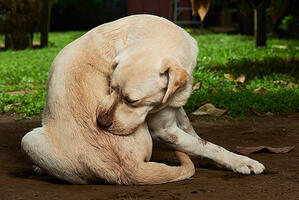 Fleas are very small creatures but they pack a really annoying punch. Fleas can be found outdoors on small rodents (though they can’t survive for long off a host) and can thus easily catch a ride on your dog and be brought inside.
Fleas are very small creatures but they pack a really annoying punch. Fleas can be found outdoors on small rodents (though they can’t survive for long off a host) and can thus easily catch a ride on your dog and be brought inside.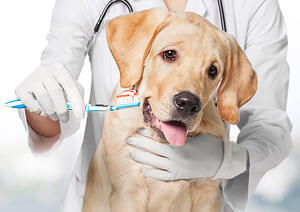 To start a brushing routine, make sure to get dog toothpaste. Human toothpaste, which contains fluoride, is not appropriate or safe to use in dogs. Start with putting some of the toothpaste on your finger, and get him used to the flavor and motion. Do this for a few days, then transition into using a brush. There are many brush types, but either a toddler toothbrush, which is small and soft, or a finger brush, which is available at many retailers can work best. The finger brush allows for an easier transition.
To start a brushing routine, make sure to get dog toothpaste. Human toothpaste, which contains fluoride, is not appropriate or safe to use in dogs. Start with putting some of the toothpaste on your finger, and get him used to the flavor and motion. Do this for a few days, then transition into using a brush. There are many brush types, but either a toddler toothbrush, which is small and soft, or a finger brush, which is available at many retailers can work best. The finger brush allows for an easier transition.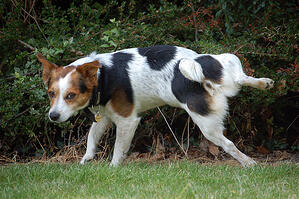 If you notice one day that your dog, who previously has had normal elimination habits, has a pee accident in the house it can be upsetting for both of you. Your dog knows she did something wrong but couldn’t help it, and you now have pee on your beautiful hardwood floor.
If you notice one day that your dog, who previously has had normal elimination habits, has a pee accident in the house it can be upsetting for both of you. Your dog knows she did something wrong but couldn’t help it, and you now have pee on your beautiful hardwood floor.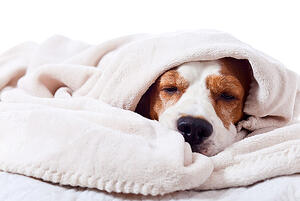 There’s a theme running through this article in that many “common” generic health problems like itchy skin and diarrhea may have a simple cause, but then again, may not. Coughing is no different.
There’s a theme running through this article in that many “common” generic health problems like itchy skin and diarrhea may have a simple cause, but then again, may not. Coughing is no different.